Introduction
In the contemporary landscape of cloud computing, effective cost management has emerged as a critical concern for organizations leveraging AWS services. As businesses increasingly rely on cloud infrastructure, understanding the intricacies of AWS pricing models, billing processes, and the tools available for monitoring expenses becomes paramount.
This article delves into essential concepts and strategies that empower organizations to navigate the complexities of AWS cost management. By examining key tools, best practices, and the challenges that arise, organizations can enhance their financial oversight, optimize resource allocation, and ultimately drive sustainable growth in a competitive environment.
Understanding AWS Cost Management: Key Concepts and Benefits
A comprehensive understanding of the various pricing models, billing processes, and the tools at your disposal is essential for knowing how to manage AWS costs effectively. Key concepts critical to this endeavor include:
- Pricing Models: It is essential to familiarize yourself with AWS's pricing options, including On-Demand, Reserved Instances, and Spot Instances.
Each model presents distinct financial implications influenced by usage patterns. As companies navigate these choices, they must consider how their specific workload requirements align with these pricing strategies. Significantly, 91% of participants acknowledge that their engineering groups possess some degree of responsibility for expenses, emphasizing the significance of team participation in financial management.
-
Billing and Charges: AWS bills users based on resource consumption, making it crucial to understand how these charges accumulate to facilitate effective management. In 2024, a report indicated that venture-backed companies express limited confidence (32%) in accurately attributing their cloud spending. This highlights the necessity for transparency in billing practices and a strong comprehension of how to manage AWS costs.
-
Benefits: Implementing effective financial management strategies not only mitigates unnecessary expenses but also enhances the capability to forecast future spending. This foresight enables better budget planning and resource allocation, contributing to overall operational efficiency.
-
Expense Allocation Tags: Utilizing expense allocation tags is vital for categorizing and tracking spending across various projects or departments.
This practice provides a clearer view of expenditure, enabling entities to identify trends and areas for potential savings.
- Case Study - Forecasting with Cost Explorer: Cost Explorer allows users to create forecasts based on their past usage of AWS services by selecting a future time range. These forecasts help estimate AWS bills and set alarms and budgets.
However, it is crucial to recognize that forecasts may differ in precision, with an 80% prediction interval signifying a range of possible expenditure based on historical usage fluctuations. By thoroughly grasping these concepts, entities can establish a solid framework for learning how to manage AWS costs, ultimately resulting in more informed financial decision-making and strategic resource management. For further insights into AWS expense management, refer to the Cost Explorer Advanced Options, which provide valuable tools for forecasting and tracking spending.
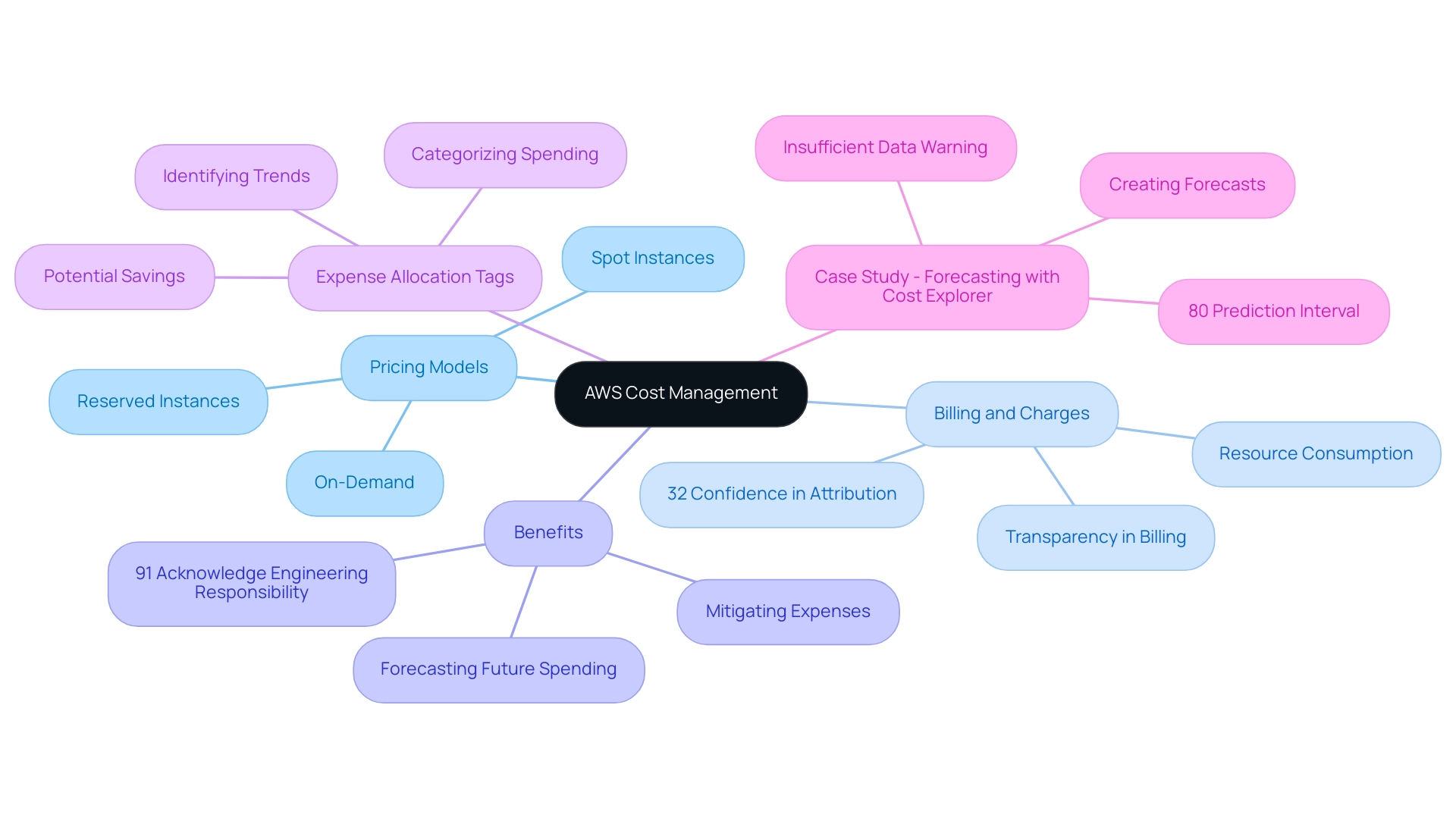
Essential Tools for Effective AWS Cost Management
To effectively manage AWS expenses, organizations can leverage several strategic tools:
- AWS Cost Explorer: This powerful tool features an intuitive interface that allows users to visualize and analyze spending patterns with ease. It allows filtering expenses by service, linked account, or usage type, providing a clear picture of where resources are allocated. Recent statistics indicate that Cost Explorer refreshes financial data at least once every 24 hours, ensuring timely insights into spending trends. Case studies have demonstrated that entities utilizing Cost Explorer have significantly lowered their unforeseen expenses by gaining improved visibility into their spending behaviors.
- AWS Budgets: This tool empowers users to set custom cost and usage budgets, alerting them when spending exceeds predefined thresholds. Such proactive measures are critical in assisting entities in understanding how to manage AWS costs and maintain financial discipline. As industry expert Cody Slingerland notes, knowing how to manage AWS costs is essential for effective cloud financial management. For instance, several entities have successfully implemented AWS Budgets, resulting in a marked reduction in overspending.
- AWS Cost and Usage Reports (CUR): By generating detailed reports, CUR provides deep insights into resource utilization and associated expenses. This level of detail allows for precise tracking and thorough analysis, which is invaluable for organizations seeking to understand how to manage AWS costs. The CUR is especially designed for advanced analytics integration, making it a crucial element of any financial management strategy. Notably, companies that have utilized CUR have reported improved accuracy in their financial forecasting.
- Amortized Expenses: Grasping amortized expenses is essential for organizations employing AWS commitments like Amazon EC2 Reserved Instances or Savings Plans. These expenses reflect the total amount distributed over the usage period, combining upfront and recurring fees. This insight assists businesses in planning their budgets more effectively and comprehending the long-term financial consequences of their investments.
- Third-Party Solutions: Tools like CloudHealth and CloudCheckr provide advanced analytics and reporting capabilities that complement AWS's native offerings. These external solutions can improve transparency regarding spending in the digital environment, allowing entities to adopt stronger financial management strategies.
By utilizing these tools, entities can attain better insight into their AWS expenditures and learn how to manage AWS costs, enabling them to make knowledgeable choices that result in efficient expenditure optimization. The launch of AWS Cost Explorer and Usage Reports has greatly tackled the difficulties of financial management, as demonstrated in case studies where entities have effectively utilized these tools to gain clearer insights into their cloud expenses.
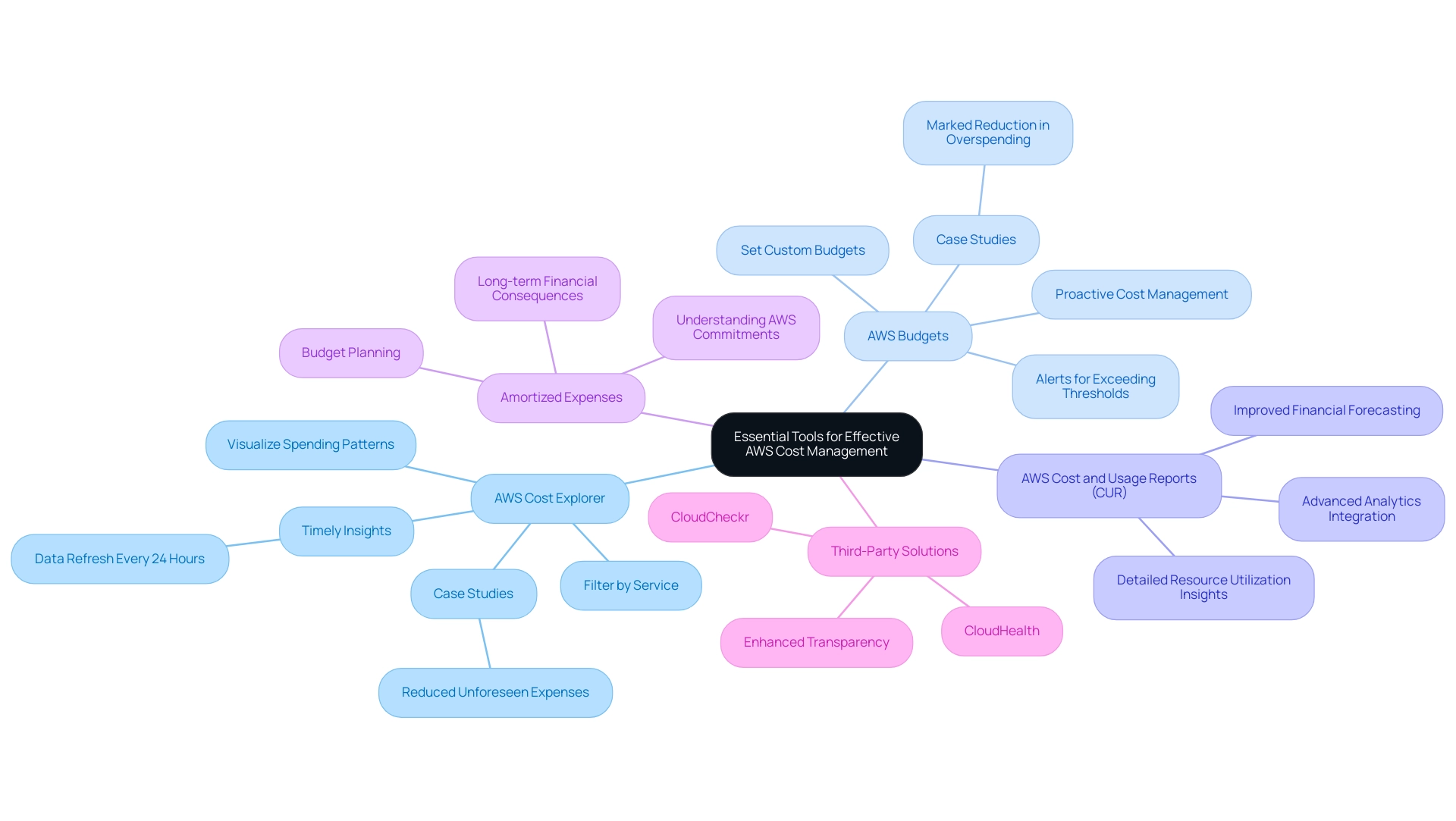
Strategies for Reducing AWS Costs: Best Practices and Techniques
To effectively reduce AWS expenses, organizations should implement the following best practices:
-
Rightsize Resources: Conduct regular assessments of your resource utilization to ensure that instances align with your actual operational requirements. Research shows that companies that consistently rightsize their resources can attain reductions of up to 36% compared to those keeping unoptimized instances. This practice not only reduces waste but also aligns with broader trends in the cloud industry, where Microsoft Azure Stack usage has seen significant growth, highlighting the importance of efficiency in cloud spending.
-
Utilize Reserved Instances: For workloads with predictable demand, investing in Reserved Instances can yield substantial savings—up to 75% compared to On-Demand pricing. This strategy not only improves financial efficiency but also offers budget predictability, enabling organizations to allocate resources more effectively.
-
Implement Auto Scaling: Leverage AWS Auto Scaling to dynamically adjust your computing capacity in response to fluctuating demand. This guarantees that you only incur expenses for the resources actively in use, optimizing expenditure further.
-
Delete Unused Resources: Conduct regular audits of your AWS environment to identify and remove unused or underutilized resources, such as idle EC2 instances and unneeded EBS volumes. This proactive method can prevent unnecessary charges and streamline your infrastructure, effectively demonstrating how to manage AWS costs, which is a significant concern highlighted by StormForge, noting that as spending rises, so does waste.
-
Leverage Spot Instances: For workloads that are flexible, consider utilizing Spot Instances, which can provide significant savings over standard pricing. These situations enable companies to take advantage of AWS’s excess capacity at lower expenses.
Implementing these strategies will not only improve financial efficiency in AWS but also provide insights on how to manage AWS costs while creating a more sustainable computing infrastructure. Effective implementations, exemplified by numerous case studies, show that companies like Drift have succeeded in saving $2.4 million each year through savvy expenditure management strategies. By adopting these best practices, CTOs can navigate the competitive landscape of cloud services more effectively, ensuring that their enterprises remain agile and cost-effective.
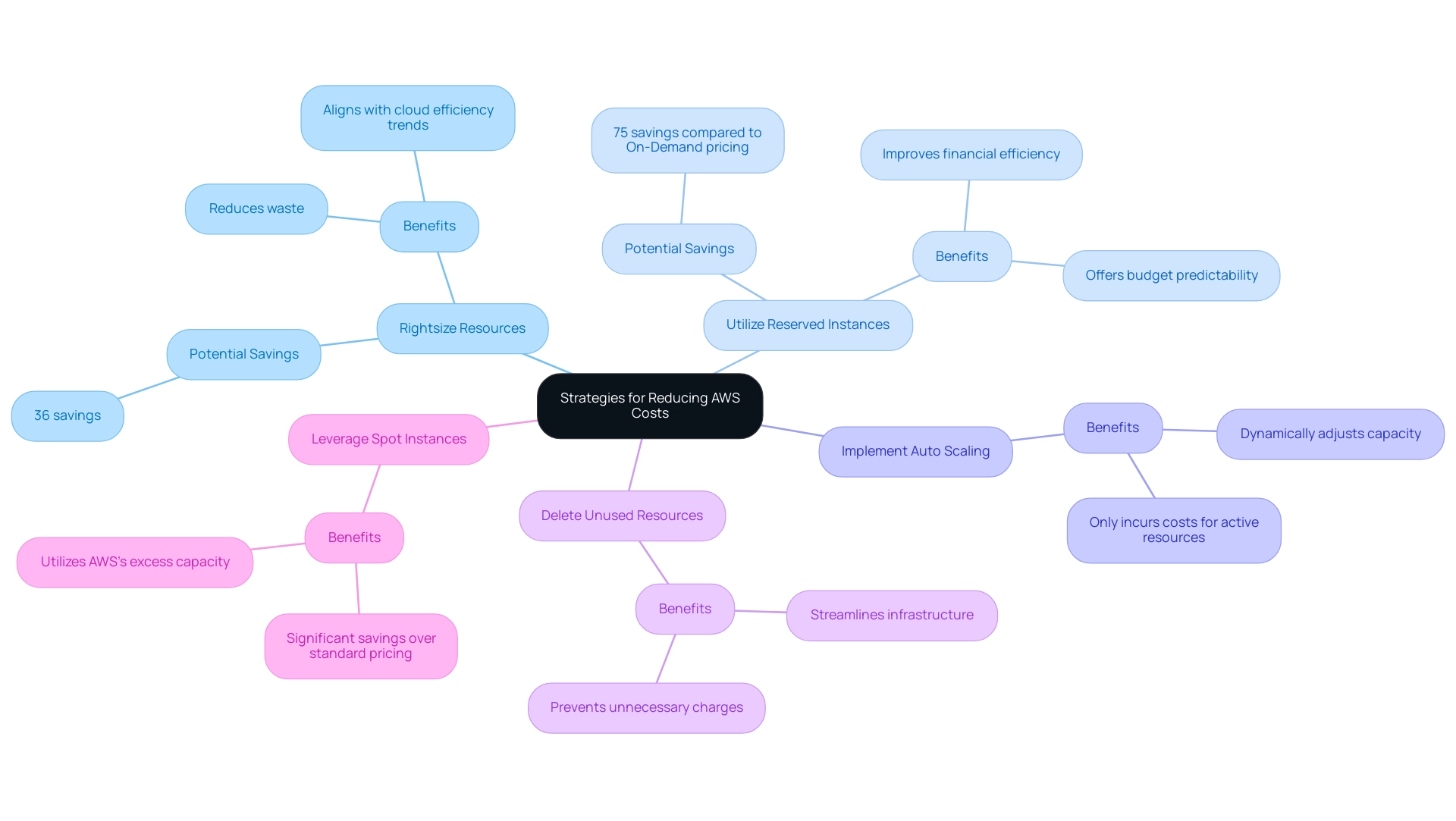
Navigating the Challenges of AWS Cost Management
Understanding how to manage AWS costs is essential for companies, as it presents a multitude of challenges that can significantly influence their financial performance. Key challenges include:
-
Complex Pricing Structures: AWS offers an extensive array of services, each with various pricing models, making accurate cost prediction a daunting task.
This complexity often leads to confusion and unexpected expenses for many organizations, highlighting the need for understanding how to manage AWS costs. -
Lack of Visibility: The absence of robust monitoring tools can hinder an organization’s ability to track spending patterns effectively.
A notable report in 2024 revealed that only 32% of venture-backed companies felt confident in attributing their spending accurately, underscoring the pervasive visibility issues that many face.
This lack of confidence highlights the need for improved financial management practices in these firms, particularly in understanding how to manage AWS costs. -
Resource Sprawl: As development teams deploy resources independently, the risk of resource sprawl increases, resulting in a proliferation of unused or underutilized assets.
This not only complicates expense management but also exacerbates wasteful spending. -
Changing Business Needs: The dynamic nature of business requirements often necessitates adjustments to cloud resources.
This fluidity can result in varying expenses that are difficult to manage, particularly if not handled with a proactive approach.
Grasping these challenges enables organizations to apply focused strategies on how to manage AWS costs effectively and lessen their effects. For instance, utilizing AI-driven predictive analytics can assist in forecasting potential price increases based on historical patterns, enabling better budget management. Moreover, CloudKeeper has effectively supported more than 300 enterprises in attaining exceptional and sustainable savings, showcasing the potential advantages of efficient expense management strategies.
As 91% of engineering teams recognize some level of ownership over cloud expenses, fostering a culture of accountability is crucial for driving more effective management practices.
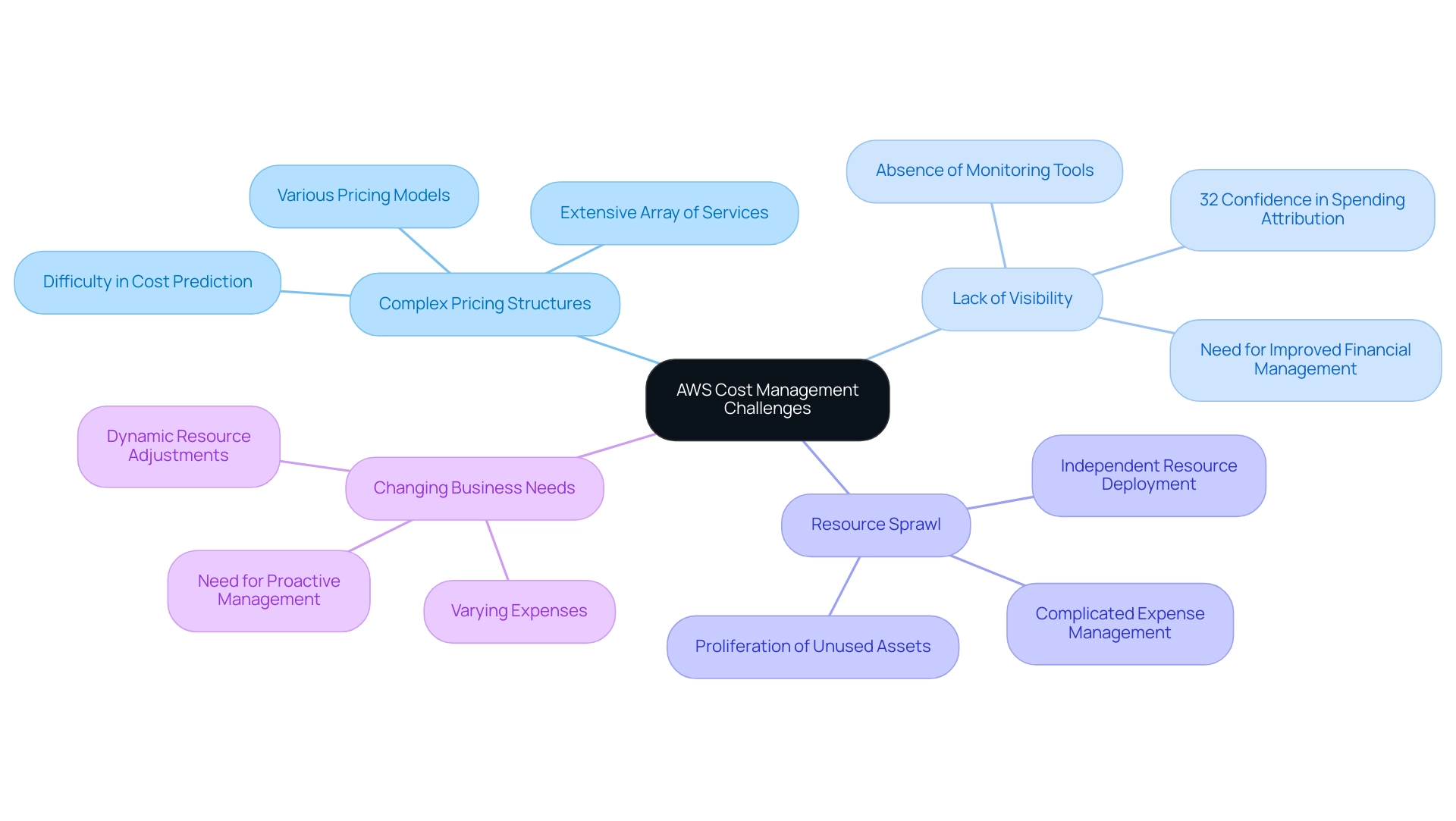
Monitoring and Analyzing AWS Costs: Tools and Techniques
To effectively monitor and analyze AWS expenses, organizations should implement the following advanced techniques:
-
Set Up Cost Alerts: Leverage AWS Budgets to establish alerts that notify you when your spending approaches 80 percent of your budgeted amount. This proactive approach ensures that you remain informed about how to manage AWS costs and can take timely action to mitigate potential overspending. It is crucial to set budget permissions that allow notifications to be sent to the designated Amazon SNS topic, with necessary subscription acceptance. Users should also be aware of potential delays in receiving these notifications, as highlighted in a case study on AWS Budgets, which noted that there can be a lag between incurring charges and receiving alerts. Comprehending how to manage AWS costs is crucial to prevent unforeseen expenses that surpass budget limits.
-
Analyze Cost Trends: Regularly utilize AWS Cost Explorer to scrutinize spending trends over time. This tool provides insights that empower you to make informed decisions, optimize resource allocation, and identify areas where savings can be achieved.
-
Conduct Regular Audits: Schedule periodic assessments of your AWS resources and related expenses to ensure they align with your budgetary constraints. This practice not only aids in identifying discrepancies but also demonstrates how to manage AWS costs effectively.
-
Utilize Expense Anomaly Detection: Implement advanced expense anomaly detection tools that automate the identification of unexpected spending patterns. These tools enable rapid responses to unusual charges, reducing the risk of budget overruns. While AWS Budgets effectively tracks expenses, users should be aware that it does not support tag-based expense allocation, which means tag information will not appear in usage data outputs.
By integrating these sophisticated monitoring techniques, organizations can understand how to manage AWS costs while maintaining robust control over their expenditures, ensuring that their cloud investments yield optimal returns. As Cody Slingerland, a FinOps certified practitioner, emphasizes, effective collaboration with internal teams is key to developing successful expense management strategies. This collaboration enhances the overall effectiveness of AWS cost monitoring practices in 2024.
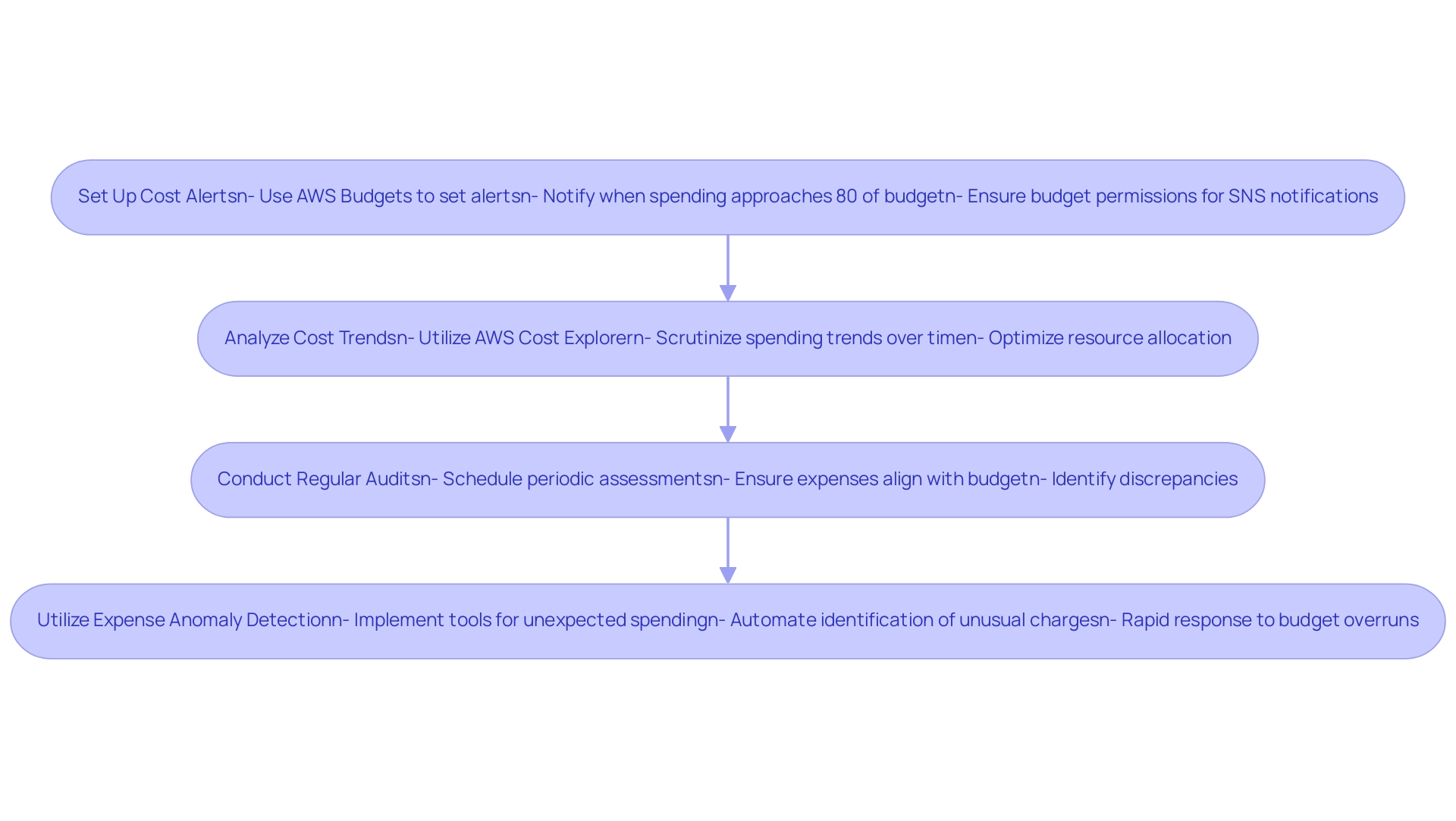
Conclusion
Effectively managing AWS costs is essential for organizations aiming to optimize their cloud investments and drive sustainable growth. By understanding the diverse pricing models, such as:
- On-Demand
- Reserved Instances
- Spot Instances
businesses can align their resource usage with the most cost-effective options available. Awareness of billing processes and the significance of cost allocation tags further enhances financial oversight, allowing for better tracking and categorization of expenses.
Utilizing tools like AWS Cost Explorer and AWS Budgets empowers organizations to visualize spending patterns, set financial parameters, and react proactively to budget thresholds. Combining these tools with best practices, such as:
- Rightsizing resources
- Implementing auto-scaling
can lead to substantial cost reductions and improved resource efficiency. Overcoming challenges like complex pricing structures and resource sprawl is crucial; adopting comprehensive monitoring techniques ensures that organizations remain agile and informed in their cost management efforts.
In conclusion, a strategic approach to AWS cost management not only mitigates unnecessary expenses but also fosters a culture of accountability within teams. By leveraging the right tools and practices, organizations can achieve enhanced financial performance and maintain competitiveness in the ever-evolving cloud landscape. As cloud adoption continues to rise, prioritizing effective cost management will be pivotal in achieving long-term success and sustainability.




